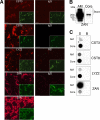Functional amyloids in the mouse sperm acrosome
- PMID: 24797071
- PMCID: PMC4097662
- DOI: 10.1128/MCB.00073-14
Functional amyloids in the mouse sperm acrosome
Abstract
The acrosomal matrix (AM) is an insoluble structure within the sperm acrosome that serves as a scaffold controlling the release of AM-associated proteins during the sperm acrosome reaction. The AM also interacts with the zona pellucida (ZP) that surrounds the oocyte, suggesting a remarkable stability that allows its survival despite being surrounded by proteolytic and hydrolytic enzymes released during the acrosome reaction. To date, the mechanism responsible for the stability of the AM is not known. Our studies demonstrate that amyloids are present within the sperm AM and contribute to the formation of an SDS- and formic-acid-resistant core. The AM core contained several known amyloidogenic proteins, as well as many proteins predicted to form amyloid, including several ZP binding proteins, suggesting a functional role for the amyloid core in sperm-ZP interactions. While stable at pH 3, at pH 7, the sperm AM rapidly destabilized. The pH-dependent dispersion of the AM correlated with a change in amyloid structure leading to a loss of mature forms and a gain of immature forms, suggesting that the reversal of amyloid is integral to AM dispersion.
Figures






Similar articles
-
Transitional states of acrosomal exocytosis and proteolytic processing of the acrosomal matrix in guinea pig sperm.Mol Reprod Dev. 2011 Dec;78(12):930-41. doi: 10.1002/mrd.21387. Epub 2011 Sep 14. Mol Reprod Dev. 2011. PMID: 21919109 Free PMC article.
-
Zona pellucida-mediated acrosomal exocytosis in mouse spermatozoa: characterization of an intermediate stage prior to the completion of the acrosome reaction.Dev Biol. 1991 Jun;145(2):344-55. doi: 10.1016/0012-1606(91)90133-n. Dev Biol. 1991. PMID: 2040376
-
Acrosomal exocytosis of mouse sperm progresses in a consistent direction in response to zona pellucida.J Cell Physiol. 2009 Sep;220(3):611-20. doi: 10.1002/jcp.21781. J Cell Physiol. 2009. PMID: 19373867
-
Protein tyrosine phosphorylation and signal transduction during capacitation-acrosome reaction and zona pellucida binding in human sperm.Arch Androl. 1996 Jul-Aug;37(1):47-55. doi: 10.3109/01485019608988501. Arch Androl. 1996. PMID: 8827347 Review.
-
Modes of acrosin functioning during fertilization.Gene. 2013 Sep 10;526(2):75-9. doi: 10.1016/j.gene.2013.05.058. Epub 2013 Jun 4. Gene. 2013. PMID: 23747402 Review.
Cited by
-
Detection of extracellular vesicles in the mouse vaginal fluid: Their delivery of sperm proteins that stimulate capacitation and modulate fertility.J Cell Physiol. 2019 Aug;234(8):12745-12756. doi: 10.1002/jcp.27894. Epub 2018 Dec 7. J Cell Physiol. 2019. PMID: 30536802 Free PMC article.
-
Search for functional amyloid structures in chicken and fruit fly female reproductive cells.Prion. 2020 Dec;14(1):278-282. doi: 10.1080/19336896.2020.1859439. Prion. 2020. PMID: 33300441 Free PMC article.
-
A new era for understanding amyloid structures and disease.Nat Rev Mol Cell Biol. 2018 Dec;19(12):755-773. doi: 10.1038/s41580-018-0060-8. Nat Rev Mol Cell Biol. 2018. PMID: 30237470 Free PMC article. Review.
-
Reversible, functional amyloids: towards an understanding of their regulation in yeast and humans.Cell Cycle. 2018;17(13):1545-1558. doi: 10.1080/15384101.2018.1480220. Epub 2018 Aug 2. Cell Cycle. 2018. PMID: 29963943 Free PMC article. Review.
-
Serum amyloid P component: a new biomarker for low sperm concentration?Asian J Androl. 2021 Sep-Oct;23(5):450-455. doi: 10.4103/aja.aja_7_21. Asian J Androl. 2021. PMID: 33723096 Free PMC article.
References
Publication types
MeSH terms
Substances
Grants and funding
LinkOut - more resources
Full Text Sources
Other Literature Sources
Molecular Biology Databases
